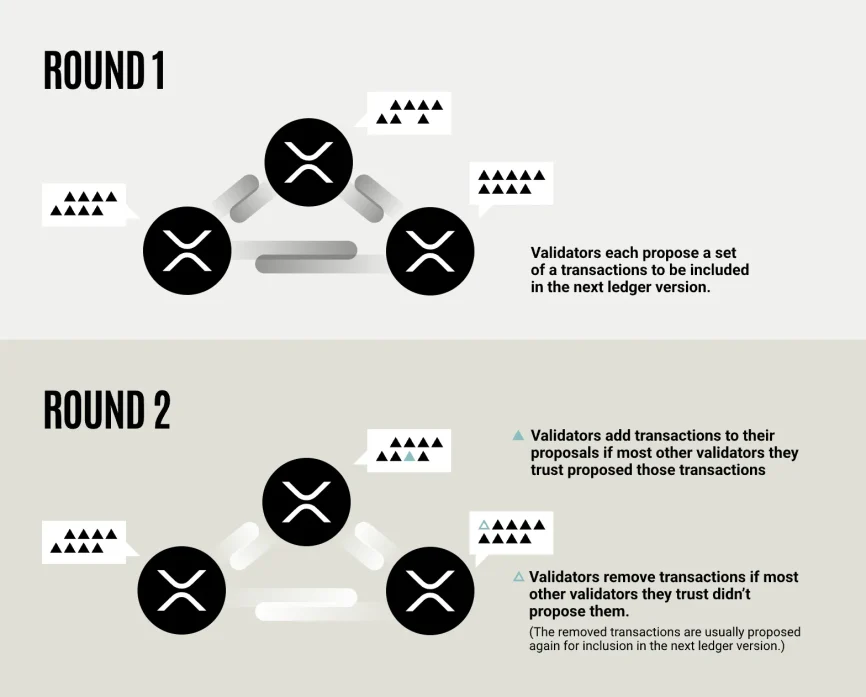What is XRP (Ripple)?
The XRP Ledger (XRPL) is a public, open-source network that reaches agreement without mining.
Table of contents:
Independent validators keep Unique Node Lists (UNLs); when roughly 80% of a node’s trusted validators approve a candidate ledger, it closes – giving deterministic finality in 3-5 seconds.

Fees are deliberately tiny and burned (anti-spam), so even high-frequency flows remain economical. Governance happens through “amendments”: features activate after sustained supermajority support.
Ripple vs XRP difference: Ripple is a company building payments products (formerly RippleNet, now Ripple Payments). XRP is the digital asset that runs on XRPL. Ripple does not control XRPL.
What is XRP used for?
- Cross-border payments & remittances: a leading cross-border payments crypto system where speed and cost matter.
- Liquidity bridge between fiat currencies: reduce pre-funding by converting into XRP, transferring on XRPL, and settling into the destination currency.
- Micropayments / on-demand liquidity (ODL): stream small payments, aggregate off-chain, settle on-chain within seconds.
- Exchange base currency on XRPL: XRPL’s native DEX lets you trade XRP and issued tokens (fiat IOUs, asset tokens).
Why businesses use XRP
- Speed: XRP transaction speed averages 3-5 seconds with deterministic finality.
- Low Fees: fractions of a cent per transaction – attractive for payout and marketplace models.
- Scalability: designed for 1,500+ TPS on commodity hardware.
- Sustainability: consensus uses minimal energy – stable and fast crypto for business operations.
- Liquidity: effective bridge asset between fiat and crypto, especially for multi-corridor flows.
What businesses should know about XRP
When it comes to XRP, businesses should first understand the regulatory landscape.
U.S. courts haven’t classified XRP itself as a security; only Ripple’s institutional sales violated Section 5 – ending with a $125M penalty (final judgment Aug 7, 2024; case closed Aug 8, 2025).
Next, XRP’s decentralisation model differs from Bitcoin and Ethereum, using a UNL-based consensus often viewed as more curated.
In treasury contexts, XRP competes with stablecoins and CBDCs, which may offer greater accounting stability.
Also, because XRP remains a free-floating asset, many companies choose to auto-convert holdings into fiat or stablecoins to minimise exposure to market volatility.
| Feature | XRP | Bitcoin | SWIFT (bank transfers) |
|---|---|---|---|
| Transaction speed | 3-5 seconds | 10 minutes | 1-5 business days |
| Fees | Fractions of a cent | Several USD (variable) | High (intermediaries, 2-7%) |
| Scalability | 1,500+ TPS | 7 TPS | Limited by banking hours |
| Energy use | Very low (eco-friendly) | High (PoW mining) | N/A |
| Best use case | Cross-border payments, liquidity | Store of value, investment | International banking settlements |
How businesses can use XRP with CoinsPaid
With CoinsPaid, businesses can manage their Ripple XRP treasury with role-based controls, accept payments directly on their websites, and send global payouts to partners and affiliates, all within a single, regulated environment.
Conversions between XRP, fiat, and other assets are available at competitive rates, while built-in AML/KYB and on-chain monitoring provide full compliance coverage from a trusted provider.
What is XRP (Ripple)? (Video)
Step-by-Step: Start with XRP via CoinsPaid
- Register & complete KYB.
- Choose an integration: checkout, API, or plugins (eCommerce, SaaS, iGaming).
- Enable XRP: add it to supported assets and set auto-conversion rules (e.g., XRP→EUR/USDC).
- Test: run sandbox payments, webhooks, and payout flows.
- Launch: go live with XRP payments; monitor flows in your dashboard; adjust routing.
Real-world applications of XRP
- Banks & fintechs: remittances and on-demand liquidity corridors where pre-funding is costly.
- E-commerce: fast international checkout with lower operational costs.
- SaaS: global subscriptions, refunds, and regional pricing.
- Payroll & affiliates: cross-border salary and partner payouts at scale.
FAQ: What is XRP?
No. This is the classic Ripple vs XRP difference: Ripple is a fintech company that builds payment products (formerly RippleNet, now Ripple Payments). XRP is the digital asset that runs on the open-source XRP Ledger (XRPL). Ripple builds on XRPL but doesn’t own or control it.
XRPL reaches deterministic finality in about 3-5 seconds. Network fees are extremely low (the base cost is 10 drops = 0.00001 XRP), which supports high-frequency XRP payments at scale.
In August 2025, the SEC-Ripple case formally concluded. The court left in place a $125,035,150 civil penalty and an injunction related to institutional sales; it confirmed that programmatic sales on public exchanges were not securities. Regulation still varies by context and jurisdiction, so always check the latest guidance and seek counsel.
For cross-border payments crypto use cases, XRP offers fast settlement (3-5s) and low fees, which can improve cash flow and reduce friction in multi-currency corridors. Ripple’s enterprise stack (Ripple Payments, formerly RippleNet) uses XRP in some corridors as a bridge asset to reduce pre-funding, while XRPL itself provides reliable, low-energy infrastructure – useful when you need stable and fast crypto for business operations (speed/cost stability, not price-pegged).
Yes. With CoinsPaid, you can accept Ripple XRP for business via plugins or API, auto-convert into 40+ fiat currencies, run mass payouts, and stay covered with an Estonia-licensed provider. This is XRP payments explained in practice – simple checkout, quick settlement, optional instant conversion.
Disclaimer: Information is for educational purposes only and is not financial or legal advice. Regulations change quickly – always verify requirements in your jurisdiction.
Other Terms from the Crypto Industry